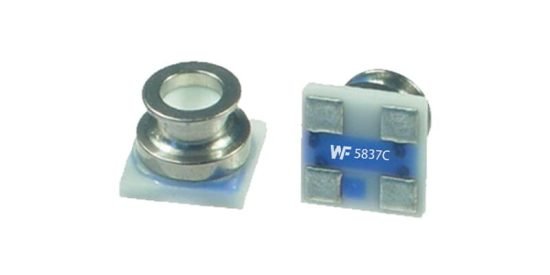Katalog
Achieving height resolution within 10 cm with barometers — which ones can do it?
Relying solely on an ordinary barometer (whether piezoresistive, capacitive, or MEMS silicon resonant type) makes it almost impossible to stably and reliably realise a 10-centimetre height resolution in arbitrary environments.
Why it’s so hard
1. Physical limit: the pressure–height relationship
Standard sea-level atmospheric pressure is about 101,325 Pa. Under standard sea-level conditions, a 10-centimetre increase in height reduces atmospheric pressure by roughly 0.012 Pa. That’s an incredibly tiny change. By comparison, the air disturbance caused by an adult casually walking around a room can easily produce pressure changes of several pascals. Opening or closing doors and windows, an air-con unit switching on or off, or even a light breeze will cause pressure fluctuations far larger than 0.012 Pa.
2. Limitations of the sensors themselves
Noise and resolution: although many high-performance MEMS barometers (for example WF280A, WF5837C) offer very fine digital resolution (e.g. 0.01 Pa), that does not mean their accuracy or stability actually meets that level. Internal sensor noise, temperature drift and long-term stability all introduce errors — and those errors are typically far larger than the pressure difference corresponding to a 10-centimetre height change.
Absolute accuracy vs relative accuracy: barometers are usually rated by absolute accuracy (for example ±50 Pa), which corresponds to about ±0.5 metres in height. More important for this use case is relative accuracy, or short-term stability — i.e. how precisely you can measure height changes over short intervals. Even the best consumer MEMS barometers, in ideal static conditions, will struggle to consistently achieve relative height resolution better than about 20–30 centimetres.
In elevator black-box projects, the WF5837C02BA from WF has been used to calculate elevator

For assisting phone GPS positioning or health apps (like recording floors climbed), low-power products such as the WF280A are commonly used.

Which “barometers” or technical approaches can get close to — or reach — this target?
Although a single ordinary barometer won’t do the job, with special designs, sensor fusion or non-traditional techniques you can approach or even achieve 10-centimetre level height resolution:
1. Differential pressure (two-sensor) height measurement systems This is the most likely method to achieve ultra-high precision in certain scenarios.
● Principle: use two high-precision pressure sensors — one as a reference station (fixed at a known height) and the other as a mobile station (mounted on the device whose height you want to measure). The system reads both sensors in real time and calculates the difference.
● Why it works: taking the difference cancels out a lot of common-mode noise — those environmental pressure fluctuations that affect both sensors (such as weather changes, drafts, etc.). What remains is the static pressure difference between the two sensors, which depends only on their relative height.
● Achievable precision: in environments with little interference and when the sensors are fairly close (for example indoors, in a mine, or within the same building), such a system can in theory reach centimetre-level or even millimetre-level relative height resolution. This approach is used in research, industrial inspection and some specialised UAV applications.
2. Deep fusion with an IMU (inertial measurement unit)
● Principle: a lone barometer is vulnerable to airflow disturbances, but an IMU (accelerometers and gyros) can measure short-term motion and attitude changes — including vertical acceleration — very precisely. By using algorithms such as a Kalman filter to fuse IMU short-term measurements with the barometer’s long-term absolute height reference, you can combine the strengths of both sensors.
● Effect: fusion helps smooth out spikes and glitches in the pressure data and provides a more stable, smoother height estimate in dynamic situations (like a UAV in flight or a moving phone). In some moments or over short intervals this can allow inference down to the 10-centimetre scale, but performance still strongly depends on the IMU quality and the fusion algorithm.
Konklusjon
So, if you need stable, reliable height resolution within 10 centimetres, consider engineering solutions based on the differential pressure measurement principle (or high-quality sensor fusion) rather than relying on a single conventional barometer.
Introduksjonen ovenfor skraper bare overflaten av applikasjonene til trykksensorteknologi. Vi vil fortsette å utforske de ulike typene sensorelementer som brukes i ulike produkter, hvordan de fungerer, og deres fordeler og ulemper. Hvis du vil ha mer detaljer om hva som er diskutert her, kan du sjekke det relaterte innholdet senere i denne veiledningen. Hvis du er presset på tid, kan du også klikke her for å laste ned detaljene i denne veiledningen Lufttrykkssensorprodukt PDF -data.
For mer informasjon om andre sensorteknologier, vennligst Besøk Sensors -siden vår.
